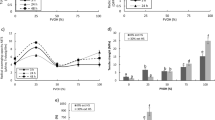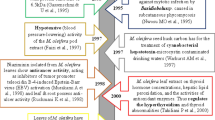Abstract
Terrestrial plants rely on protection conferred by their outer coverings to defend against desiccation, bruising, and microbial invasion. For food staples such as potato tubers, the periderm contains the phellem (tuber skin) which creates a hydrophobic barrier by depositing macromolecular composites comprised of waxes, soluble phenolics, and a complex aliphatic suberin polyester (or suberin aliphatic domain) and lignin-like biopolymer (or suberin polyphenolic domain) within the previously formed polysaccharide cell wall. The antibacterial activity of both the soluble chemical constituents and their solid polymeric assemblies provides essential plant defense; their antioxidant and waterproofing properties also offer practical potential for sustainable food preservation and packaging applications. To characterize these phytochemical composites comprehensively and in molecular detail, we developed an approach that coordinates ‘bottom-up’ analysis of extracted metabolites that include suberin precursors, solid-state NMR spectroscopy of the polymers in intact skins or solid suspensions, and ‘top-down’ analysis of chemical breakdown products of suberin. The usefulness of analytical methods that include LC–MS, GC–MS, multivariate analysis, solid-state NMR, SEM, and TEM is illustrated for studies of molecular and supramolecular structures that underlie protective function in three potato periderm systems: (1) native tuber periderms versus suberized wound-healing tissues including closing layer and wound periderm; (2) metabolites unleashed in rapid response to wounding prior to formation of suberized tissues; (3) wild type versus genetically modified potato varieties with altered suberin deposition. We also demonstrate how enrichment with stable 13C and 15N isotopes can improve our understanding of how the suberin biopolymer molecular structure develops, increasing the reach of MS, 2D solid-state NMR, and dynamic nuclear polarization spectroscopic methods and revealing phenolic amide constituents that could represent an underappreciated part of the plant’s defensive arsenal.
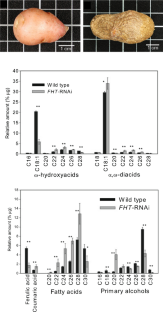

Copyright 2015 Elsevier
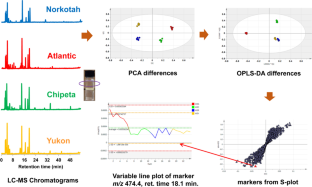
Copyright 2014 American Chemical Society
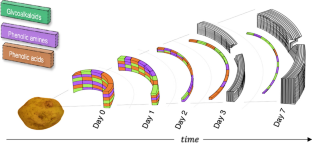
Copyright 2019 Elsevier
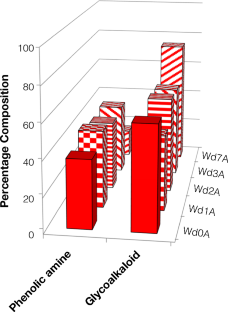
Copyright 2019 Elsevier

Copyright 2015 American Chemical Society


Copyright 2018 Elsevier

Copyright 2014 American Chemical Society




Copyright 2020 Elsevier
Similar content being viewed by others
Abbreviations
- CPMAS:
-
Cross polarization magic-angle spinning
- DARR:
-
Dipolar-assisted rotational resonance
- DCP:
-
Double cross polarization
- DNP:
-
Dynamic nuclear polarization
- FHT:
-
Fatty ω-hydroxyacid/fatty alcohol hydroxycinnamoyl transferase
- GC:
-
Gas chromatography
- IR:
-
Infrared spectroscopy
- LC:
-
Liquid chromatography
- MS:
-
Mass spectrometry
- OPLS-DA:
-
Orthogonal partial least-squares discriminate analysis
- PCA:
-
Principal component analysis
- Phe:
-
Phenylalanine
- SEM:
-
Scanning electron microscopy
- ssNMR:
-
Solid-state NMR
- SPIDER:
-
Saturation-Pulse Induced Dipolar Exchange with Recoupling
- TOF:
-
Time-of-flight mass spectrometry
References
Addison B, Stengel D, Bharadwaj VS, Happs RM, Doeppke C, Wang T, Bomble YJ, Holland GP, Harman-Ware AE (2020) Selective one-dimensional 13C-13C spin-diffusion solid-state nuclear magnetic resonance methods to probe spatial arrangements in biopolymers including plant cell walls, peptides, and spider silk. J Phys Chem B 124(44):9870–9883. https://doi.org/10.1021/acs.jpcb.0c07759
Baldus M, Geurts DG, Hediger S, Meier BH (1996) Efficient 15N-13C polarization transfer by adiabatic-passage Hartmann-Hahn cross polarization. J Magn Reson Ser A 118(1):140–144. https://doi.org/10.1006/jmra.1996.0022
Bernards MA (2002) Demystifying suberin. Can J Bot 80:227–240. https://doi.org/10.1139/b02-017
Bernards MA, Lewis NG (1996) Suberin: an hydroxycinnamic acid-derived polymer. Polyphen Actual 14:4–7
Bernards MA, Lopez ML, Zajicek J, Lewis NG (1995) Hydroxycinnamic acid-derived polymers constitute the polyaromatic domain of suberin. J Biol Chem 270:7382–7386
Borg-Olivier O, Monties B (1993) Lignin, suberin, phenolic acids and tyramine in the suberized, wound-induced potato periderm. Phytochemistry 32(3):601–606
Company-Arumi D, Figueras M, Salvado V, Molinas M, Serra O, Antico E (2016) The Identification and quantification of suberin monomers of root and tuber periderm from potato (Solanum tuberosum) as fatty acyl tert-butyldimethylsilyl derivatives. Phytochem Anal 27:326–335. https://doi.org/10.1002/pca.2625
Correia VG, Bento A, Pais J, Rodrigues R, Halinski LP, Frydrych M, Greenhalgh A, Stepnowski P, Vollrath F, King AWT, Silva Pereira C (2020) The molecular structure and multifunctionality of the cryptic plant polymer suberin. Mater Today Bio 5:100039. https://doi.org/10.1016/j.mtbio.2019.100039
Dastmalchi K, Cai Q, Zhou K, Huang WL, Serra O, Stark RE (2014) Solving the jigsaw puzzle of wound-healing potato cultivars: metabolite profiling and antioxidant activity of polar extracts. J Agric Food Chem 62(31):7963–7975. https://doi.org/10.1021/jf501330h
Dastmalchi K, Kallash L, Wang I, Phan VC, Huang W, Serra O, Stark RE (2015) Defensive armor of potato tubers: nonpolar metabolite profiling, antioxidant assessment, and solid-state NMR compositional analysis of suberin-enriched wound-healing tissues. J Agric Food Chem 63:6810–6822. https://doi.org/10.1021/acs.jafc.5b03206
Dastmalchi K, Rodriguez MP, Lin JN, Yoo B, Stark RE (2019) Temporal resistance of potato tubers: antibacterial assays and metabolite profiling of wound-healing tissue extracts from contrasting cultivars. Phytochemistry 159:75–89. https://doi.org/10.1016/j.phytochem.2018.12.007
Dastmalchi K, Chira O, Rodriguez MP, Yoo B, Serra O, Figueras M, Stark RE (2021) A chemical window into the impact of RNAi silencing of the StNAC103 gene in potato tuber periderms: soluble metabolites, suberized cell walls, and antibacterial defense. Phytochemistry 190:112885. https://doi.org/10.1016/j.phytochem.2021.112885
Dominguez E, Heredia-Guerrero JA, Heredia A (2017) The plant cuticle: old challenges, new perspectives. J Exp Bot 68(19):5251–5255. https://doi.org/10.1093/jxb/erx389
Duan P, Schmidt-Rohr K (2017) Composite-pulse and partially dipolar dephased multiCP for improved quantitative solid-state 13C NMR. J Magn Reson 285:68–78. https://doi.org/10.1016/j.jmr.2017.10.010
Duncan T (1990) Compilation of chemical shift anisotropies.
Ferreira R, Garcia H, Sousa AF, Guerreiro M, Duarte FJS, Freire CSR, Calhorda MJ, Silvestre AJD, Kunz W, Rebelo LPN, Pereira CS (2014) Unveiling the dual role of the cholinium hexanoate ionic liquid as solvent and catalyst in suberin depolymerisation. RSC Adv 4(6):2993–3002. https://doi.org/10.1039/c3ra45910a
Fich EA, Segerson NA, Rose JK (2016) The Plant Polyester Cutin: Biosynthesis, Structure, and Biological Roles. Annu Rev Plant Biol 67:207–233. https://doi.org/10.1146/annurev-arplant-043015-111929
Franke R, Briesen I, Wojciechowski T, Faust A, Yephremov A, Nawrath C, Schreiber L (2005) Apoplastic polyesters in Arabidopsis surface tissues–a typical suberin and a particular cutin. Phytochemistry 66:2643–2658. https://doi.org/10.1016/j.phytochem.2005.09.027
Fraser CM, Chapple C (2011) The phenylpropanoid pathway in Arabidopsis. Arabidopsis Book 9:e0152. https://doi.org/10.1199/tab.0152
Garcia H, Ferreira R, Petkovic M, Ferguson JL, Leitao MC, Gunaratne HQN, Seddon KR, Rebelo LPN, Pereira CS, Leitão MC, Silva Pereira C (2010) Dissolution of cork biopolymers in biocompatible ionic liquids. Green Chem 12:367. https://doi.org/10.1039/b922553f
Ghassemi N, Poulhazan A, Deligey F, Mentink-Vigier F, Marcotte I, Wang T (2022) Solid-state NMR investigations of extracellular matrices and cell walls of algae, bacteria, fungi, and plants. Chem Rev 122(10):10036–10086. https://doi.org/10.1021/acs.chemrev.1c00669
Graça J (2015) Suberin: the biopolyester at the frontier of plants. Front Chem 3:62. https://doi.org/10.3389/fchem.2015.00062
Graça J, Pereira H (2000) Methanolysis of bark suberins: analysis of glycerol and acid monomers. Phytochem Anal 11:45–51
Graça J, Santos S (2007) Suberin: the biopolyester of plants’ skin. Macromol Biosci 7:128–135
Graça J, Cabral V, Santos S, Lamosa P, Serra O, Molinas M, Schreiber L, Kauder F, Franke R (2015) Partial depolymerization of genetically modified potato tuber periderm reveals intermolecular linkages in suberin polyester. Phytochemistry 117:209–219. https://doi.org/10.1016/j.phytochem.2015.06.010
Guzman-Puyol S, Benitez JJ, Heredia-Guerrero JA (2021) Sustainable bio-based polymers: towards a circular bioeconomy. Polymers (Basel). https://doi.org/10.3390/polym14010022
Holloway PJ (1983) Some variations in the composition of suberin from the cork layers of higher plants. Phytochemistry 22:495–502
Huang WL, Serra O, Dastmalchi K, Jin LQ, Yang LJ, Stark RE (2017) Comprehensive MS and solid-state NMR metabolomic profiling reveals molecular variations in native periderms from four Solanum tuberosum potato cultivars. J Agric Food Chem 65(10):2258–2274. https://doi.org/10.1021/acs.jafc.6b05179
Jin LQ, Cai Q, Huang WL, Dastmalchi K, Rigau J, Molinas M, Figueras M, Serra O, Stark RE (2018) Potato native and wound periderms are differently affected by down-regulation of FHT, a suberin feruloyl transferase. Phytochemistry 147:30–48. https://doi.org/10.1016/j.phytochem.2017.12.011
Johnson RL, Schmidt-Rohr K (2013) Quantitative solid-state 13C NMR with signal enhancement by multiple cross polarization. J Magn Reson 239:44–49. https://doi.org/10.1016/j.jmr.2013.11.009
Kang X, Kirui A, Dickwella Widanage MC, Mentink-Vigier F, Cosgrove DJ, Wang T (2019) Lignin-polysaccharide interactions in plant secondary cell walls revealed by solid-state NMR. Nat Commun 10(1):347. https://doi.org/10.1038/s41467-018-08252-0
Kelly JE, Chrissian C, Stark RE (2020) Tailoring NMR experiments for structural characterization of amorphous biological solids: a practical guide. Solid State Nucl Magn Reson 109:101686. https://doi.org/10.1016/j.ssnmr.2020.101686
Kim HK, Choi YH, Verpoorte R (2010) NMR-based metabolomic analysis of plants. Nat Protocols 5:536–549
King RR, Calhoun LA (2005) Characterization of cross-linked hydroxycinnamic acid amides isolated from potato common scab lesions. Phytochemistry 66:2468–2473. https://doi.org/10.1016/j.phytochem.2005.07.014
Kolattukudy PE (1984) Biochemistry and function of cutin and suberin. Can J Bot 62:2918–2933
Kolattukudy PE (2001) Polyesters in higher plants. Adv Biochem Eng Biotechnol 71:1–49
Landgraf R, Smolka U, Altmann S, Eschen-Lippold L, Senning M, Sonnewald S, Weigel B, Frolova N, Strehmel N, Hause G, Scheel D, Böttcher C, Rosahl S (2014) The ABC transporter ABCG1 is required for suberin formation in potato tuber periderm. Plant Cell 26:3403–3415. https://doi.org/10.1105/tpc.114.124776
Li-Beisson Y, Shorrosh B, Beisson F, Andersson MX, Arondel V, Bates PD, Baud S, Bird D, Debono A, Durrett TP, Franke RB, Graham IA, Katayama K, Kelly AA, Larson T, Markham JE, Miquel M, Molina I, Nishida I, Rowland O, Samuels L, Schmid KM, Wada H, Welti R, Xu C, Zallot R, Ohlrogge J (2013) Acyl-lipid metabolism. Arabidopsis Book 11:e0161. https://doi.org/10.1199/tab.0161
Lulai EC (2007) Tuber quality. Potato biology and biotechnology: advances and perspectives. Elsevier, Amsterdam
Marques AV, Pereira H (2019) A methodological approach for the simultaneous quantification of glycerol and fatty acids from cork suberin in a single GC run. Phytochem Anal 30(6):687–699. https://doi.org/10.1002/pca.2846
Moire L, Schmutz A, Buchala A, Yan B, Stark RE, Ryser U (1999) Glycerol is a suberin monomer. New experimental evidence for an old hypothesis. Plant Physiol 119:1137–1146
Morcombe CR, Gaponenko V, Byrd RA, Zilm KW (2004) Diluting abundant spins by isotope edited radio frequency field assisted diffusion. J Am Chem Soc 126:7196–7197. https://doi.org/10.1021/ja047919t
Moreira CJS, Bento A, Pais J, Petit J, Escorcio R, Correia VG, Pinheiro A, Halinski LP, Mykhaylyk OO, Rothan C, Silva Pereira C (2020) An ionic liquid extraction that preserves the molecular structure of cutin shown by nuclear magnetic resonance. Plant Physiol 184(2):592–606. https://doi.org/10.1104/pp.20.01049
Negrel J, Pollet B, Lapierre C (1996) Ether-linked ferulic acid amides in natural and wound periderms of potato tuber. Phytochemistry 43:1195–1199
Perez Rodriguez M, Dastmalchi K, Yoo B, Stark RE (2020) Needle in a haystack: antibacterial activity-guided fractionation of a potato wound tissue extract. Bioorg Med Chem 28(9):115428. https://doi.org/10.1016/j.bmc.2020.115428
Philippe G, Sorensen I, Jiao C, Sun X, Fei Z, Domozych DS, Rose JK (2020) Cutin and suberin: assembly and origins of specialized lipidic cell wall scaffolds. Curr Opin Plant Biol 55:11–20. https://doi.org/10.1016/j.pbi.2020.01.008
Ranathunge K, Schreiber L, Franke R (2011) Suberin research in the genomics era—new interest for an old polymer. Plant Sci 180:399–413. https://doi.org/10.1016/j.plantsci.2010.11.003
Razem FA, Bernards MA (2002) Hydrogen peroxide is required for the poly(phenolic) domain formation during wound-induced suberization. J Agric Food Chem 50:1009–1015
Rodrigues R, Palma SI, Correia VG, Padrao I, Pais J, Banza M, Alves C, Deuermeier J, Martins C, Costa HM, Ramou E (2020) Sustainable plant polyesters as substrates for optical gas sensors. Mater Today Bio 8:100083. https://doi.org/10.1016/j.mtbio.2020.100083
Schaefer J, McKay RA, Stejskal EO (1979) Double cross-polarization NMR of solids. J Magn Res 34:443–447
Schmidt-Rohr K, Mao JD (2002) Selective observation of nitrogen-bonded carbons in solid-state NMR by saturation-pulse induced dipolar exchange with recoupling. Chem Phys Lett 359:403–411
Schreiber L, Franke R, Hartmann K (2005) Wax and suberin development of native and wound periderm of potato (Solanum tuberosum L.) and its relation to peridermal transpiration. Planta 220:520–530. https://doi.org/10.1007/s00425-004-1364-9
Serra O, Soler M, Hohn C, Franke R, Schreiber L, Prat S, Molinas M, Figueras M (2009a) Silencing of StKCS6 in potato periderm leads to reduced chain lengths of suberin and wax compounds and increased peridermal transpiration. J Exp Bot 60:697–707. https://doi.org/10.1093/jxb/ern314
Serra O, Soler M, Hohn C, Sauveplane V, Pinot F, Franke R, Schreiber L, Prat S, Molinas M, Figueras M (2009b) CYP86A33-targeted gene silencing in potato tuber alters suberin composition, distorts suberin lamellae, and impairs the periderm’s water barrier function. Plant Physiol 149:1050–1060. https://doi.org/10.1104/pp.108.127183
Serra O, Hohn C, Franke R, Prat S, Molinas M, Figueras M (2010) A feruloyl transferase involved in the biosynthesis of suberin and suberin-associated wax is required for maturation and sealing properties of potato periderm. Plant J 62:277–290. https://doi.org/10.1111/j.1365-313X.2010.04144.x
Serra O, Chatterjee S, Huang W, Stark RE (2012) Mini-review: what nuclear magnetic resonance can tell us about protective tissues. Plant Sci 195:120–124. https://doi.org/10.1016/j.plantsci.2012.06.013
Serra O, Chatterjee S, Figueras M, Molinas M, Stark RE (2014) Deconstructing a plant macromolecular assembly: chemical architecture, molecular flexibility, and mechanical performance of natural and engineered potato suberins. Biomacromol 15:799–811
Serra O, Mahonen AP, Hetherington AJ, Ragni L (2022) The making of plant armor: the periderm. Annu Rev Plant Biol 73:405–432. https://doi.org/10.1146/annurev-arplant-102720-031405
Soler M, Verdaguer R, Fernandez-Pinan S, Company-Arumi D, Boher P, Gongora-Castillo E, Valls M, Antico E, Molinas M, Serra O, Figueras M (2020) Silencing against the conserved NAC domain of the potato StNAC103 reveals new NAC candidates to repress the suberin associated waxes in phellem. Plant Sci 291:110360. https://doi.org/10.1016/j.plantsci.2019.110360
Stark RE, Yu B, Zhong J, Yan B, Wu G, Tian S (2013) Environmental NMR: high-resolution magic-angle spinning. eMagRes. 2:377–388
Stark REYB, Yu B, Zhong J, Yan B, Wu G, Tian S (2014) Environmental NMR: high-resolution magic-angle spinning. In: Simpson MJS, André J (eds) NMR spectroscopy: a versatile tool for environmental research. John Wiley and Sons Ltd, New York, pp 87–102
Takegoshi K, Nakamura S, Terao T (2001) 13C–1H dipolar-assisted rotational resonance in magic-angle spinning NMR. Chem Phys Lett 344:631–637
Tedeschi G, Benitez JJ, Ceseracciu L, Dastmalchi K, Itin B, Stark RE, Heredia A, Athanassiou A, Heredia-Guerrero JA (2018) Sustainable fabrication of plant cuticle-like packaging films from tomato pomace agro-waste, beeswax, and alginate. Acs Sustain Chem Eng 6(11):14955–14966. https://doi.org/10.1021/acssuschemeng.8b03450
Wiklund S (2008) Multivariate Data Analysis and Modelling in “Omics”.228
Worley B, Powers R (2013) Multivariate analysis in metabolomics. Curr Metabol 1:92–107. https://doi.org/10.2174/2213235X11301010092
Yan B, Stark RE (1998) A WISE NMR approach to heterogeneous biopolymer mixtures: dynamics and domains in wounded potato tissues. Macromolecules 31:2600–2605
Yan B, Stark RE (2000) Biosynthesis, molecular structure, and domain architecture of potato suberin: A 13C NMR study using isotopically labeled precursors. J Agric Food Chem 48:3298–3304. https://doi.org/10.1021/jf000155q
Yang WL, Bernards MA (2007) Metabolite profiling of potato (Solanum tuberosum L.) tubers during wound-induced suberization. Metabolomics 3:147–159. https://doi.org/10.1007/s11306-007-0053-7
Yu B, Vengadesan G, Wang H, Jashi L, Yefremov T, Tian S, Gaba V, Shomer I, Stark RE (2006) Magic-angle spinning NMR studies of cell wall bound aromatic-aliphatic biopolyesters associated with strengthening of intercellular adhesion in potato (Solanum tuberosum L.) tuber parenchyma. Biomacromol 7:937–944. https://doi.org/10.1021/bm050812t
Zhao W, Deligey F, Chandra Shekar S, Mentink-Vigier F, Wang T (2022) Current limitations of solid-state NMR in carbohydrate and cell wall research. J Magn Reson 341:107263. https://doi.org/10.1016/j.jmr.2022.107263
Acknowledgements
The authors thank Drs. Hsin Wang and Lijia Yang for valuable technical assistance with the NMR and GC-MS instrumentation, respectively, at The City College of New York (CCNY). We express our appreciation to Dr. Boris Itin for technical assistance with the ssNMR and DNP instrumentation at the New York Structural Biology Center (NYSBC). Contributors to our previously published work described in this review included Drs. Wenlin Huang and Barney Yoo, Ph.D. students Liqing Jin and Qing Cai, undergraduate Mathiu Perez Rodriguez, and high school student Janni Lin. This work was supported by grants from the U.S. National Science Foundation (NSF award MCB-1411984 to R.E.S.), the U.S. Department of Agriculture (2022-67014-36387 to R.E.S.), and the Spanish Ministerio de Ciencia, Innovación y Universidades (PID2019-110330GB-C21/MICIU/AEI/10.13039/501100011033) to M.F. and O.S.). The Q-TOF MS instrument was acquired through NSF award CHE-1228921 and is operated by the CUNY Hunter College Department of Chemistry. The GC-MS instrument was acquired through NSF award CHE-0840498. Infrastructural support for the solid-state NMR spectrometer was provided by The City College of New York, the CUNY Institute for Macromolecular Assemblies, and a grant from the U.S. National Institutes of Health (5G12MD007603-30, National Institute on Minority Health and Health Disparities). The NMR instruments at the NYSBC were obtained through a grant from the New York State Office of Science, Technology and Academic Research, an NIH Office of Research Infrastructure Program Facility Improvement Grant (CO6RR015495), and an NIH Equipment Grant (S10RR029249).
Author information
Authors and Affiliations
Corresponding author
Ethics declarations
Conflict of interest
The authors have no competing interests to declare that are relevant to the content of this article.
Additional information
Publisher's Note
Springer Nature remains neutral with regard to jurisdictional claims in published maps and institutional affiliations.
Rights and permissions
Springer Nature or its licensor (e.g. a society or other partner) holds exclusive rights to this article under a publishing agreement with the author(s) or other rightsholder(s); author self-archiving of the accepted manuscript version of this article is solely governed by the terms of such publishing agreement and applicable law.
About this article
Cite this article
Dastmalchi, K., Phan, V.C., Chatterjee, S. et al. A comprehensive approach to phytochemical analysis of macromolecular composites that protect tubers: case studies in suberized potato periderm tissues. Phytochem Rev (2024). https://doi.org/10.1007/s11101-024-09974-4
Received:
Accepted:
Published:
DOI: https://doi.org/10.1007/s11101-024-09974-4



